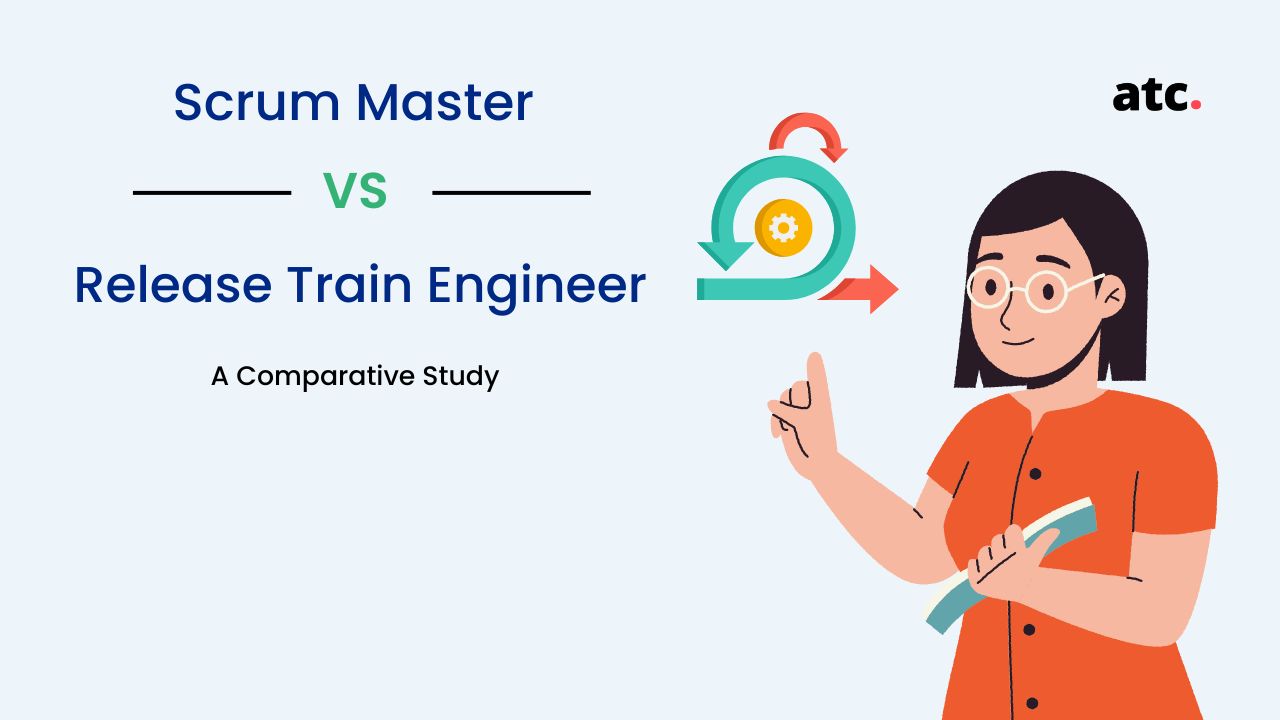Subscribe to the blog
In today's challenging job market, marked by layoffs, budget cuts, and recession fears, workers under 30 face unprecedented stress and burnout. In such times, making well-informed career choices becomes paramount.
It is crucial to reflect on your career decisions and whether they will benefit you in the long run and focus on how to add new skills. As speed and resilience becomes a priority worldwide, Agility will be a default part of every organization. And if you are thinking about pursuing a career as an Agile expert, it is critical to explore the top Agile career paths and decide which one is the right one for you.
This guide will provide a comparative study of Release Train Engineer vs Scrum Master, including the roles and responsibilities, career path, and skillsets to make an informed decision. You will also get an overview of how tech certifications play a role in career growth.
Understanding the Role of a Release Train Engineer (RTE)
An RTE acts as a servant leader facilitating events and processes for Agile Release Train (ARTs) and project teams. They follow Agile and Lean principles and aim for continuous improvement to ensure teams deliver maximum customer value.
Now that we have understood the role of an RTE, let’s review their top responsibilities:
- Facilitating Program Increment (PI) planning: The RTE facilitates PI planning sessions, where all Agile teams collaborate to define and plan the work for the upcoming program increment. They ensure that PI objectives and dependencies are clear.
- Supports PI execution: During PI execution, an RTE assists in tracking progress, facilitates periodic synchronization of events, supports backlog refinement, and promotes DevOps principles to optimize the flow.
- Agile coaching: Guiding Agile teams, Scrum Masters and Product Owners on Agile practices and SAFe principles is the primary responsibility of an RTE. They resolve challenges and foster a culture of continuous improvement.
- Conducting workshops: At the end of each program increment, the RTE plays a key role in facilitating the Inspect and Adapt (I&A) workshops. These workshops provide valuable opportunities for teams to reflect on their performance, identify areas for improvement, and define actionable steps for the next increment.
- Track and improve: The RTE is responsible for monitoring the ART performance, establishing pull systems to optimize flow, facilitating value stream mapping, and taking proactive measures to eliminate risks and cross-team dependencies.
Essential Skills and Characteristics an RTE should have
Ensuring the smooth functioning of ARTs is undoubtedly the most crucial responsibility of an RTE. However, managing a diverse team of over 150 members, including software engineers, product owners, and specialists, presents unique challenges.
It requires empathetic yet assertive leadership.
Here are five must-have skills an RTE should have to guide Agile teams toward project success.
- Communication and Transparency
Open communication and transparency form the bedrock of managing large and complex projects. As an RTE, you have many duties, including facilitating SAFe events like PI Planning, tracking progress, assisting product owners, and driving relentless improvement.
Additionally, you should also keep all stakeholders well-informed and engage with them to avoid confusion and save time.
To accomplish such tasks, you should be an excellent communicator and work actively towards building a transparent culture. It is critical to be upfront, empathize with others, and support the team’s commitment from start to finish.
- Agile Expertise
Agility is at the core of transforming change into growth. By embodying the Agile mindset, RTEs facilitate SAFe events enabling teams and stakeholders to come together, align their efforts, inspect challenges, and adapt for improvement.
Having Agile expertise helps you break down large-scale projects into manageable increments, empowering ARTs in decision-making and quickly adapting to market needs.
- Understanding of Servant Leadership
Becoming an RTE means essentially becoming a servant leader. Although the philosophy became popular in the 1970s when Robert K. Greenleaf penned an essay, few understand the model. From how it works to key principles, you need to study the servant leadership model and practice it effectively to create a positive impact on your team.
According to Greenleaf, the most critical characteristic of a servant leader is to serve rather than lead. Instead of acting like a traditional leader, this model tells you to listen, empathize, and seek to understand others' perspectives.
- Empathy
The central role of an RTE is to guide ARTs in achieving business goals and support them whenever they want.
But doing this requires you to connect with them on a personal level. And this is where empathy comes in.
Being empathetic includes listening to your team members, seeing things from multiple perspectives, and addressing emotions to make everyone feel heard and understood. As an RTE, empathy allows you to identify potential impediments, build trust, resolve conflicts, and understand team dynamics for better collaboration and productivity.
- Negotiation
As you will have to collaborate with multiple stakeholders and set objectives for upcoming increments, negotiation helps to keep things smooth.
Negotiation skills allow you to find optimal solutions that balance constraints, prioritize critical product features, and find common ground.
Release Train Engineer vs Scrum Master: How do they differ?
After exploring the essential duties and characteristics of an RTE, you may start wondering how the role differs from that of a Scrum Master.
Because a Scrum Master also follows the servant leadership model, facilitates Agile events, and guides team members towards successful delivery.
So how do both roles differ?
The answer lies in the scope of work.
Let’s understand this with a side-by-side comparison:
| Roles | Release Train Engineer | Scrum Master |
| Scale of responsibilities | Manages and guides multiple Agile teams, which may comprise more than 150 members, working on complex projects. Thus, the scale of responsibilities is definitely more. | Works with a single Agile team. The number typically ranges from 5 to 10. |
| Team focus | Oversees the execution of the ARTs, tracking progress, identifying risks, and working with stakeholders to ensure the train stays on track to achieve its objectives. The team focus is at a program level. | The primary focus is at the team level. Scrum Masters work closely with a single Agile team, ensuring the team follows Agile principles and Scrum practices to deliver high-quality increments. |
| Technical efficiency | Works with high-level tools and methodologies like Kanban, CI/CD tools, information radiators, and more. | Uses simpler technical tools like Scrum boards, burn-down charts, and documentation tools. |
| Event facilitation | Facilitates program-level events like PI Planning and ART Sync. | Facilitates Scrum events like daily stand-ups, retrospectives, and sprint reviews. |
Which Career Path Should You Choose?
After comparing Release Train Engineer and Scrum Master roles, it becomes evident that while both are significant, they differ in impact, responsibilities, and required skills.
So how do you decide which one is best suitable for you? By reflecting on your skills, experience, and knowledge level.
For instance, if you are just starting in the tech field and have little experience with the SAFe framework, it is best to get trained and gain the renowned Scrum Master certification from the Scrum Institute. This will help you acquire real-world knowledge of the SAFe framework, establish credibility, and increase your chances of getting a job as a Scrum Master.
On the other hand, if you are already working with Agile teams, understand SAFe principles, and have decent experience in the industry, it is best to opt for an RTE certification. This will help in career growth.
Essentially, it all boils down to how you stand out in the job market. Tech certifications like Certified Scrum Master (CSM) and SAFe Release Train Engineer give you an edge during the hiring process and increase your chances of landing interviews and job offers.
Additionally, keep in mind, career paths are not always linear, and you can explore opportunities to transition between roles if your interests evolve.
Kickstart your career advancement journey today!
The demand for Scrum Master and RTE roles is on the rise. According to estimates from Glassdoor, Scrum Masters in the USA earn an average salary of around $115,376, while RTEs earn approximately $158,903.
And this is just the beginning.
Identifying your strengths and areas for improvement allows you to acquire relevant certifications and real-world experience, propelling your career forward.
If you have any remaining questions or need assistance in determining the career path that best suits you, don't hesitate to reach out to our training specialists. We are here to guide you in finding the certification that aligns perfectly with your interests and help you take the next steps.




